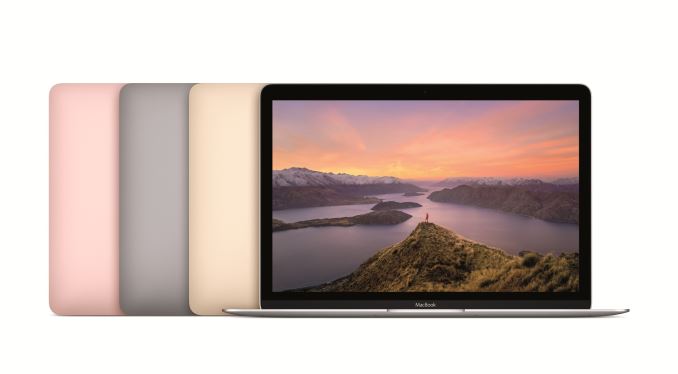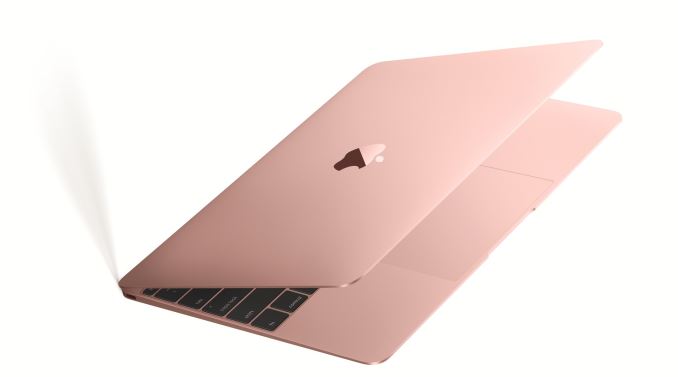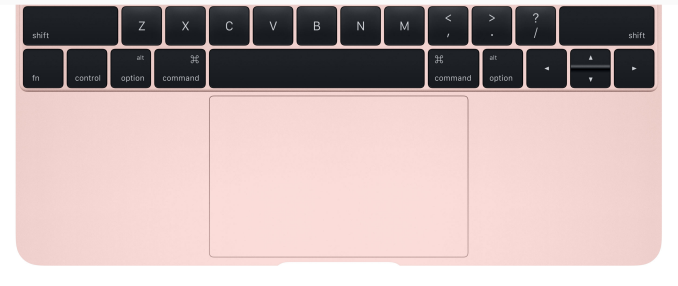Apple Refreshes MacBook with Skylake-based Core M and New Rose Gold Color
by Ian Cutress & Anton Shilov on April 19, 2016 11:10 AM EST
Today Apple has introduced its new generation of its MacBook laptops. On the specification sheets, this generation introduces Intel Skylake based Core m processors, updated integrated graphics, a faster storage solution (either controller or NAND), faster DRAM and bigger batteries. The new notebooks use the same thin chassis and retina-class display as the Broadwell-based MacBooks released last year, but in using the new Skylake silicon the new models are are expected faster and more energy-efficient, and combined with bigger batteries should mean longer battery life. Apple is also expanding the color options, bringing the popular Rose Gold option from the iPhone line to the Macbook.
The new Apple MacBook line is based on the dual-core Intel Core M processors based on the newest Skylake microarchitecture as well as the ninth-generation of Intel's integrated graphics (HD 515, Gen9) with improved media playback support. The new processors are the Core m3-6Y30, the Core m5-6Y54 and the Core m7-6Y75, but are upgraded from their listed base frequencies due to Apple using them in a 'configurable 7W TDP up' mode. This adjusts the base frequency up by 100-200 MHz and offers more TDP headroom for longer turbo periods. The latest microarchitecture and increased frequencies should increase the base performance of the new laptops in general-purpose applications whereas hardware-accelerated playback of HEVC and VP9 video streams should improve battery life in video streaming scenarios. Just like predecessors, the new laptops use 8 GB of memory, using LPDDR3 to minimize power consumption of memory sub-system. This time, Apple uses LPDDR3-1866 memory for its MacBook, which is a tad faster than the LPDDR3-1600 DRAM it used last year. This should have a knock-on effect on the integrated graphics performance as well.
| Apple MacBook Line | |||||||
| 2015 (Broadwell) | 2016 (Skylake) | ||||||
| CPU | SKU | Intel Core M-5Y31 |
Intel Core M-5Y51 |
Intel Core M-5Y71 |
Intel Core m3-6Y30 |
Intel Core m5-6Y54 |
Intel Core m7-6Y75 |
| cTDP Up | 7W cTDP Up | ||||||
| Base | 1.1 GHz | 1.2 GHz | 1.3 GHz | 1.1 GHz | 1.2 GHz | 1.3 GHz | |
| Turbo | 2.4 GHz | 2.6 GHz | 2.9 GHz | 2.2 GHz | 2.7 GHz | 3.1 GHz | |
| GPU | SKU | Intel HD Graphics 5300 (GT2) 24 EUs, Gen 8 |
Intel HD Graphics 515 (GT2) 24 EUs, Gen 9 |
||||
| Base | 300 MHz | 300 MHz | |||||
| Turbo | 850 MHz | 900 MHz | 850 MHz | 900 MHz | 950 MHz | ||
| DRAM | 8GB LPDDR3-1600 | 8GB LPDDR3-1866 | |||||
| PCIe SSD | 256 GB | 512 GB | 256 GB 512 GB |
256 GB | 512 GB | 256 GB 512 GB |
|
| PCIe 2.0 x4 | PCIe 3.0 x2 | ||||||
| Display | 12-inch 2304x1440 IPS LCD | ||||||
| Ports | 1 x USB 3.1 (Gen 1) Type-C 3.5mm combo jack |
||||||
| Network | 2x2:2 802.11ac with BT 4.0 | ||||||
| Battery | 39.7 Wh | 41.4 Wh | |||||
| Dimensions | H: 0.14-0.52-inch W: 11.04-inch D: 7.74-inch |
||||||
| Weight | 2.03 lbs (0.92 kg) | ||||||
| Colors | Space Gray Gold Silver |
Space Gray Gold Silver Rose Gold |
|||||
| Price | $1299 | $1599 | $1749 | $1299 | $1599 | $1749 ? | |
Since the chassis and the monitor essentially remained the same as last year, we are still talking about a machine with 12” IPS display panel with 2304x1440 resolution and a full-size keyboard. The maximum thickness of the new MacBook is 1.31 cm (0.52”) and the weight is 0.92 kg (2.03 pounds), similar to the first-gen model.
Apple claims that the new MacBook laptops feature upgraded solid-state storage, which relies on the PCIe bus, but it offers higher performance than the previous-gen SSD the company used on its 2015 MacBook. Last year the company essentially used its own SSD with its own controller, based on iFixit.com’s findings. Perhaps, this year Apple uses a new-gen SSD design developed in-house. Unfortunately, the company remains tight-lipped regarding the nature of its SSD improvements, but only discloses that they are faster than the predecessors. Last year's MacBook used a PCIe 2.0 x4 NVMe interface - moving to Skylake Core M and the fact that Skylake's PCH supports PCIe 3.0 by default means that the new drive is most likely PCIe 3.0, but we're not sure if it is still x4, or if something else has changed. We are asking about this!
In addition to the new components, Apple also uses larger 41.4-watt-hour lithium-polymer terraced battery, compared to a 39.7 watt-hour battery used on the previous-gen model, which should enable longer battery life. Apple itself declares up to 10 hours of wireless web browsing and up to 11 hours of iTunes movie playback, which is an hour longer than before.
The laptop still features a single USB Type-C port with 5 Gbps transfer rate, which can be used for charging, connection to an external display (up to 3840x2160 resolution at 30 Hz refresh rate is supported) and so on. The notebook also has two microphones, a TRRS connector for headsets and a 480p FaceTime camera. Wireless networking capabilities of the notebook also remained untouched: the notebook supports dual-band 2x2 802.11ac Wi-Fi as well as Bluetooth 4.0.
One element worth noting is that the use of Skylake Core M should open up features such as Speed Shift to Apple, where the system has the ability to respond quicker to CPU demands up to 30x and finish quick tasks faster than the previous generation even recognizes the request for a high-performance mode. This becomes significant for responsiveness and user experience, but Speed Shift requires specific OS support. Intel worked closely with Microsoft to enable it for Windows 10, and at this point Apple has not stated publicly if the new MacBook will support Speed Shift out of the box or will be in a future OS update.
The new Apple MacBook laptops are available from Apple directly starting today and from its partners starting April 20, 2016. The most basic Apple MacBook model with Intel Core m3-6Y30 SoC, 8 GB of memory and 256 GB of solid-state storage costs $1299. The more advanced model featuring the Core m5-6Y54 and 512 GB of storage retails for $1599. The Core m7-based model is built-to-order and its price will be higher although we expect it to be similarly priced to the upgraded Broadwell model.
Source: Apple

















106 Comments
View All Comments
JG75 - Saturday, September 24, 2016 - link
Interesting post. I bought my first mac in 2010, a 13" macbook air, because of its size and portability. The first week it was awkward, because I was used to windows pcs. Then I learned to use the trackpad and gestures, and learned to use the OS. Then I found SPOTLIGHT. The search tool for mac, which works flawlessly and fast, as opposed to the windows search tools that I had used before, that did NOTHING but turn up the fan of your pc. This is continued in all the mac software today like pictures, just as an example. The search window is VERY powerful when implemented the right way. Touchpad, no need to comment. Except: WHY do the windows pc producers continue to spew out Garbage touchpads? The question actually still baffles me.Anyway. Any man his choice.
Tegeril - Tuesday, April 19, 2016 - link
That computer is thicker, heavier, has a slower clocked cpu (900mhz), and has slower storage.There are definitely differences and OS X is a tangible one.
rozquilla - Tuesday, April 19, 2016 - link
CPU is the same model/speed at least in one of the MacBooks: Intel Core m3-6Y30, 900MHz base.Storage might be slower, but let's get real, this machine (the same specs as the ASUS) is a coffee house web browsing, I mean, social networking, tool. Both will boot in less than 10 seconds. After that, whatever OS you have installed is meaningless.
Tegeril - Wednesday, April 20, 2016 - link
Yet... the same CPU in the Mac is clocked to 1.1GHz, not 900MHz.I do software development on mine and it's only got the Broadwell chip. You're definitely underestimating the utility.
osxandwindows - Tuesday, April 19, 2016 - link
plus, I get updates for 7 years, so I'm happy to pay for the hardware.rozquilla - Tuesday, April 19, 2016 - link
I agree, Ubuntu updates are great, I bet you get more than 7 years of updates. ;)Ian Cutress - Tuesday, April 19, 2016 - link
Could argue the following:MacBook is 16:10
MacBook uses PCIe storage, not M.2 SATA
MacBook uses LPDDR3-1866, not 1600
MacBook is only 0.92kg, ASUS is 1.2 kg (+33% heavier)
But
ASUS UX305CA has Real Sense camera
ASUS has three USB 3.0 ports
I'm sure there are some others on both sides... :D
repoman27 - Tuesday, April 19, 2016 - link
BTW, last year's 12-inch MacBook actually had a PCIe 2.0 x4 SSD with custom Apple NVMe controller. Andrew Cunningham at Ars Technica initially misreported it as x2 and that seems to have stuck in the collective mind of the Internet.Ian Cutress - Tuesday, April 19, 2016 - link
I checked Ryan's review, and you're right :D So I adjusted Wiki with a reference as well.TEAMSWITCHER - Tuesday, April 19, 2016 - link
A lot of people complain that ASUS laptops have keys that break off the keyboard. And have fun with ASUS getting those keyboards fixed - they are terrible at customer support.